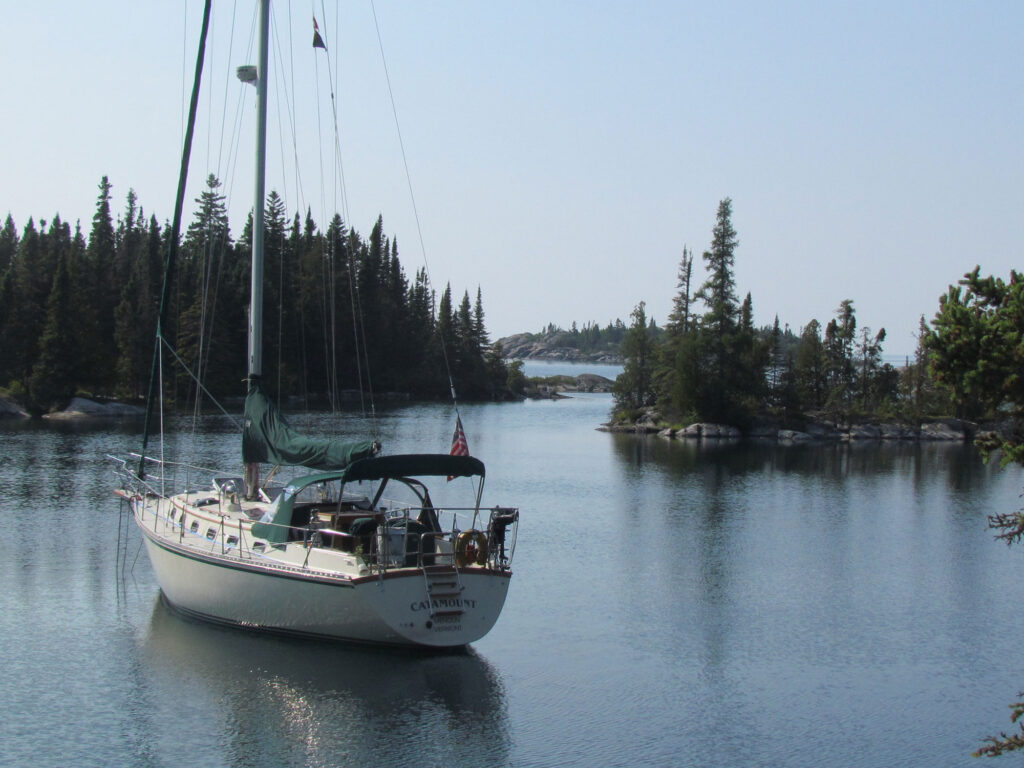
This was the question we debated all winter long: Could two 79-year-old sailors take on Lake Superior one last time?
My wife, Jennifer, and I have had the great luxury of sailing Catamount, our Caliber 38, for 18 summers on the upper Great Lakes. These summers included nine on Superior—for the past six summers with Jack, our Brittany Spaniel. But the big 8-0 is staring us squarely in the face, and we know our time afloat is nearing its end. Between Covid and Canada’s border closures, we had not been to our favorite Great Lake in four years. Was it realistic to think we could handle the biggest and baddest of all the lakes, where services are few, docks and anchorages are often 50 miles apart, and the weather has sunk many a boat over the centuries?
We got the blessings of our children and decided to give Superior another shot, but with some rules. Two long days were to be followed by a day off. Naps were encouraged. Sailing on just the jib was still sailing. Motorsailing was still sailing. Heck, even motoring would count as sailing. No more 12- or 14-hour days. No going up the mast. No beating or tacking into waves more than 2 feet high. No white-knuckle entrances into anchorages. Docks were OK. Above all, savor every moment.
Spoiler alert: We broke every one of those rules, except the last.
Lake Superior is almost 400 miles from east to west (the sun rises 35 minutes earlier at its eastern end than its western end). It has more than 2,000 miles of shoreline. Our previous trips had been up and back along the Canadian shore, or up and back along the American shore, or up one shore, across the lake and back via the other. We had never circumnavigated the whole lake. Why not go for it? In for a dime, in for a dollar.
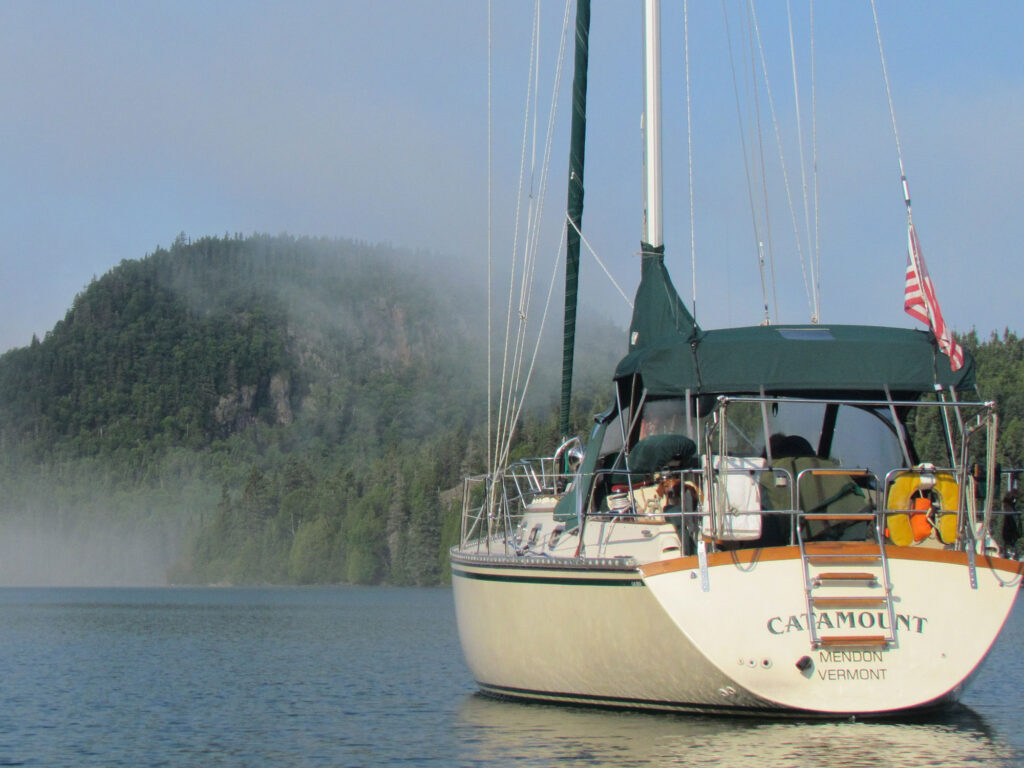
Getting to Lake Superior from our home port of Cheboygan, Michigan, means crossing 40 miles of western Lake Huron and fighting a 2-knot current for another 40 miles up the St. Marys River to the locks at Sault Ste. Marie, Michigan (the “Soo.”) But we had two days of favorable winds and sailed all the way to the Soo in early July. We felt confident we could do this.
Then another concern: If we did the American shore first, we would encounter prevailing westerly winds and a 1½-knot current that runs clockwise around the lake. That favored going up the Canadian shore first and sailing counterclockwise. But the Canadian shore is also the most dramatic, the most remote (think Maine without people or lobster pots) and has rock-bound anchorages every 5 miles or so. We wanted to save the best for last, so clockwise it was: first the American shore, then back via Canada.
At the Soo, we got our first Lake Superior forecast, including that the mid-lake weather buoy recorded a water temperature of 39 degrees. Yeah, we would be putting off swimming until August.
We were the sole occupant of the 1,200-foot-long lock that raised us 21 feet from the St. Marys River to Superior itself. What service! Then we reached 48 miles to Whitefish Point’s breakwater-protected docks, beating an eastbound fog bank by minutes. We toured the Great Lakes Shipwreck Museum with its dramatic display about the 1975 sinking of the ore carrier Edmund Fitzgerald, when the gales of November came early. We also met members of the museum’s dive team who were looking for the sunken schooner Annie M. Peterson, which disappeared nearby with its crew of seven in a late-fall storm in 1914. The 191-foot schooner had been built in 1874 by Jennifer’s great-great-great grandfather in Green Bay, Wisconsin. As we prepared to strike farther west, it was sobering to think we might be sailing over the bones of her family’s lost boat.
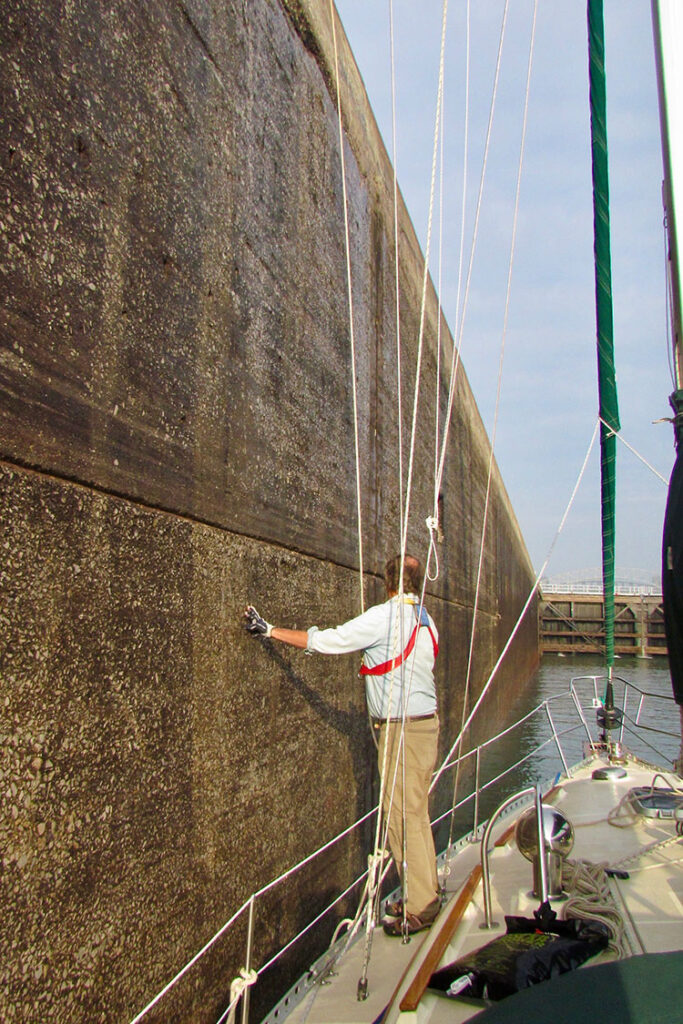
We anchored out in charming Grand Marais, Michigan, to watch Fourth of July fireworks overhead, and then sailed wing and wing along the colorful cliffs of Pictured Rocks National Lakeshore. Contrary winds and fog, interrupted only by thunderstorms, kept us up anchored in Grand Island’s Murray Bay for two days, but two longish motorsailing days got us to the Keweenaw Peninsula, a dramatic arc of land that forces its way squarely into Superior’s maw.
The Keweenaw is the remnant of a rift in the earth’s crust that filled in with copper-rich magma. Its copper mines in the late 1800s allowed the electrification of America and attracted miners from throughout Europe, most notably Finland. The town of Hancock, Michigan, sits astride the waterway that cuts through the peninsula, and is the only town you will ever visit where the street sings are in English and Finnish.
We sat in the cockpit for four hours waiting out a midnight squall with continuous lightning in Eagle Harbor, farther east on the Keweenaw’s north shore. A three-hour midday nap gave us the energy to carry on to Copper Harbor at the peninsula’s tip, where we gratefully stayed at the town’s neat-as-a-pin (and not much bigger) wilderness marina, which had bear-proof garbage cans.
Rare easterly winds pushed us west for two long days to the hardscrabble town of Ontonogan, Michigan. We goofed by not resting there a full day. Instead, we tried to beat west into 2-footers; that was OK for a few miles, but not the 48 we had to cover to get to the Apostle Islands. So, in a rare burst of good judgment, we turned back for a second night at Ontonogan. Our decision was validated when the harbormaster rewarded us with zucchini from his garden and freshly caught lake trout.
The forecast for going west the following day wasn’t great either, but it was the best forecast for the next week, so we tried it once more. The west wind repeatedly backed southwest and veered northwest, allowing us to tack six times through 90 degrees of apparent wind without once altering our westerly course for the Apostle Islands National Lakeshore. We staggered into virtually empty Julian Bay on the east side of Stockton Island and rewarded ourselves with three days off.
We have brought Catamount to the Apostles several times over the years. We love the area: lots of anchorages, sandy beaches, nothing to whack your keel, wave-carved sandstone arches and caves. Sailboats outnumber powerboats 10-to-1. We dusted off our dinghy-racing skills by beating through narrow passages, and we hiked the islands’ many trails. It is a seductive place, and our time in the islands recharged our batteries, which admittedly were getting a little low.
But our quest to circle the lake had our bow pointed west and my hometown of Duluth, Minnesota. I grew up on Superior’s rocky shores and was looking forward to bringing Catamount into Duluth’s big commercial harbor. With thunderstorms in the forecast, we left the Apostles early for the 70-mile trip. We almost made it; the storms caught us just a mile outside the harbor entrance. My glorious homecoming was in a downpour, the harbor entrance visible only on radar, but our decks were sluiced clean as we settled gratefully into Barker’s Island Marina. Owned and managed by sailors, Barker’s is the most complete and well-run, full-service marina we have ever seen. We almost wished we had boat problems to fix just so we could take advantage of their skills.
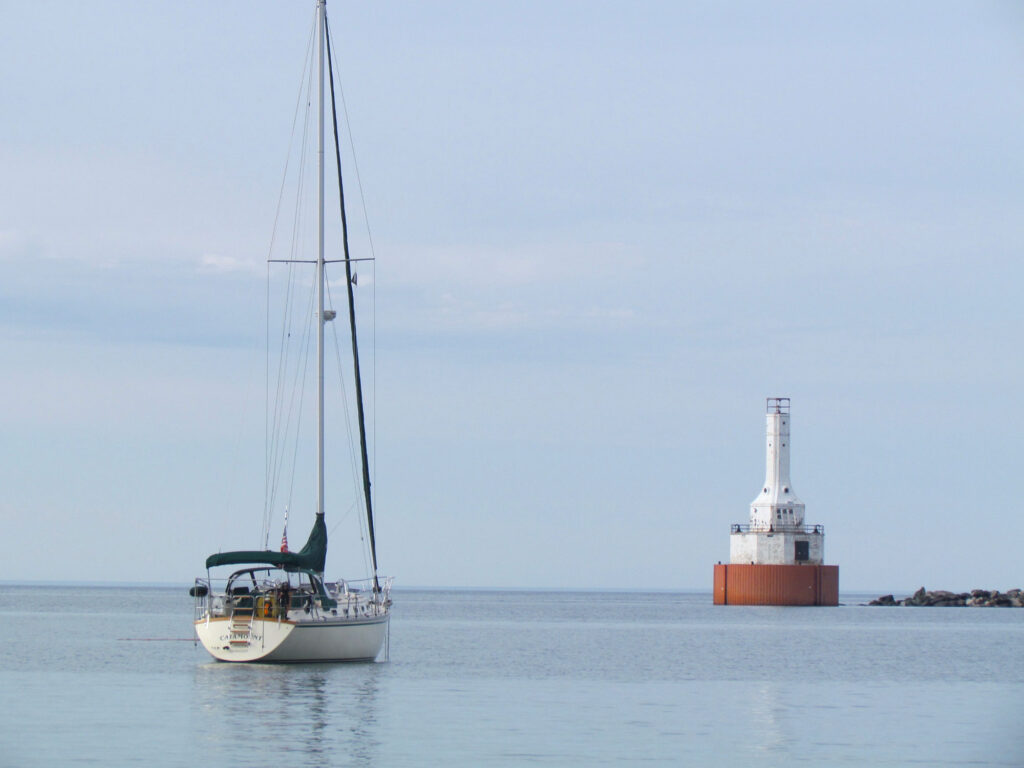
After three days of visiting with family and eating their cooking, we passed under Duluth’s Aerial Lift Bridge and headed east along Superior’s Minnesota shore, 150 miles of gorgeous but inhospitable rock cliffs and rocky beaches. Northwest winds got us nearly to hullspeed without any seas as we scooted to the only protection, first at the docks at Silver Bay and then 50 miles farther east at Grand Marais (yes, there was a Grand Marais back in Michigan too).
To our south was the looming hulk of Isle Royale National Park. The 40-mile-long island, 12 miles from Canada and 45 miles from Michigan, is American territory courtesy of some cartographic chicanery by Benjamin Franklin at the conclusion of the American Revolution. Maps of Lake Superior at the time showed three large islands in Lake Superior, with Isle Royale smack in the middle. Franklin knew there were rumors of copper deposits on the island and magnanimously said, “You guys take those two, we’ll settle for this one.” In reality, there was only one other big island in the lake; England (and later Canada) got Michipicoten Island, much smaller and less impressive than Isle Royale. We have sailed to Isle Royale several times, but we had to pass this time because they now forbid dogs in the park, even good sailing dogs like Jack.
Our first true wilderness anchorage was at the Susie Islands, just a mile from the Canadian border, where we got an American send-off with another three-hour midnight squall and electrical storm. After a day of catching up on sleep, we were finally at the jumping-off spot for Canada.
We love Canada. (Full disclosure: we have a Canadian daughter-in-law and two dual-citizenship granddaughters.) We love its people, its wilderness, its no-drama way of life. And we especially love its 350 miles of Lake Superior. After a four-year absence, we lustily sang “O Canada” while we hauled up our red maple leaf courtesy flag. We spent our first night hunkered under the 400-foot cliffs of Jarvis Bay, and washed down our version of poutine (alfredo sauce over hash browns) with two Molsons.
Superior’s Canadian shore has legendary fog when warm air from the American prairies moves over all that frigid water, and that’s what engulfed us as we crossed the 19 miles of Thunder Bay, with its commercial shipping lanes and myriad islands. Visibility fell to nothing. Distinguishing thousand-foot-long islands from thousand-foot-long freighters was tough. The radar contact we were puzzling over proved to be the latter, but the gray pall lifted just enough for us to be confident we would sail safely in front of it.
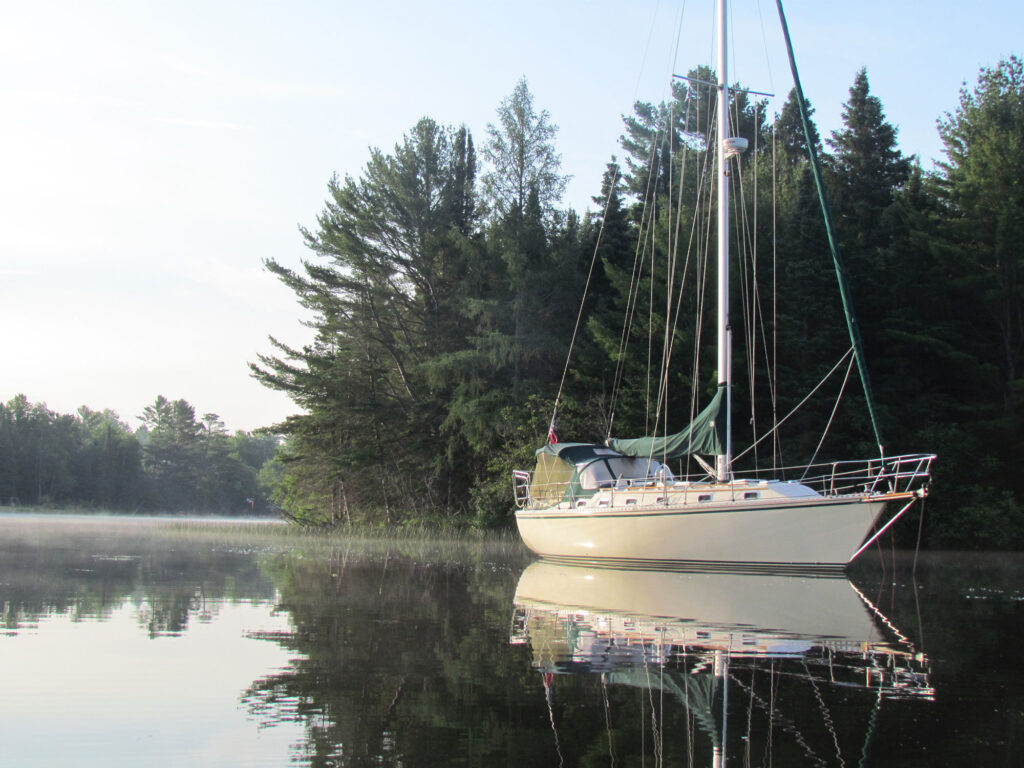
Now we were truly in the wilderness. Rocky shores, abundant anchorages, high cliffs, no other boats. As we worked our way across the top of the lake, a dilemma arose. Every hour under sail meant having to choose or ignore a world-class anchorage. The prosaically named Boat Harbour or Fish Harbour? The charmingly labeled Old Man’s Pocket or Uncle Dave’s? The fan-shaped basaltic columns and caves of Woodbine or the mile-long black sand beach of Shesheeb Bay? Tough choices. We couldn’t overnight in all of them, so we anchored for lunch stops and dog runs, then moved on every night as we worked our way east.
We cautiously threaded our way past shoals into tiny Walker Channel to take another day off, and the next day sailed between majestic cliffs directly to the anchorage in Loon Harbour. There, we dinghied to a tiny nearby island for a wilderness sauna. No one knows who built it, who maintains it and how it hasn’t burned down after all these years, but its rusty stove got the temperature up to 180 degrees. We also finally had the courage to swim in Lake Superior, with “swimming” being defined as belly-flopping into 3 feet of water and then racing back into the sauna.
We sprung for two nights at the dock in the tiny community of Red Rock, Ontario, for more fuel and Molsons. The town is so close to the 49th parallel that it’s farther north than most of Newfoundland. Then it was off to the Slate Islands in Superior’s northeast corner. We had following winds and seas, poled out the jib and put the preventer on the boom for a 20-mile wing-and-wing romp, finally dropping sail deep into the archipelago’s interior. The Slates are the remnant of an ancient meteor impact crater, and a network of cliff-studded islands protected us from a series of storms that blew through for four days. Jennifer went up the mast to retrieve a halyard I hadn’t secured properly, and when we finally hauled the anchor, we had to disengage it from a 12-foot log.
From the Slate Islands back to the Soo is 200 miles of the most remote shoreline anywhere this side of Labrador or British Columbia. We threaded between skinny islets just big enough to support solitary pine trees into well-protected Pulpwood Harbour, part of Pukaskwa National Park. It was white-knuckle time slipping past shoals with just 2 feet under our keel at the entrance into tiny Dampier Cove, surrounded by pine-fringed islands. When the forecast called for 30 knots from the northwest, we hunkered in well-protected Pilot Cove for two days, put out two anchors and a shore line, and watched 9-footers gallop by the harbor entrance.
A brief weather window allowed us to reach 30 miles with a double-reefed main and scrap jib toward Indian Harbour. We were unwilling to turn broadside into the seas to drop the main sail into the wind, and I struggled with the downwind take down, causing some anxious moments on deck (me) and in the cockpit (Jennifer) before we got it sorted out. But Indian Harbour was just as we hoped it would be: empty, protected, tranquil, restorative. Three days there seemed way too short.
As we left Indian Harbour, while motorsailing off a lee shore, the fan belt broke, leading to more anxious moments. Jennifer worked the sails while I crawled into the engine room, wrench and replacement belt in hand. It was a good thing we’d had three quiet days in Indian Harbour; this Lake Superior cruising life is tiring stuff.
By now it was late August. Nights were cooler, maple trees were changing color, and Orion had begun his autumnal march across the southern sky. When a high finally settled over the lake, it was time to head south, and we hustled back to the Soo.
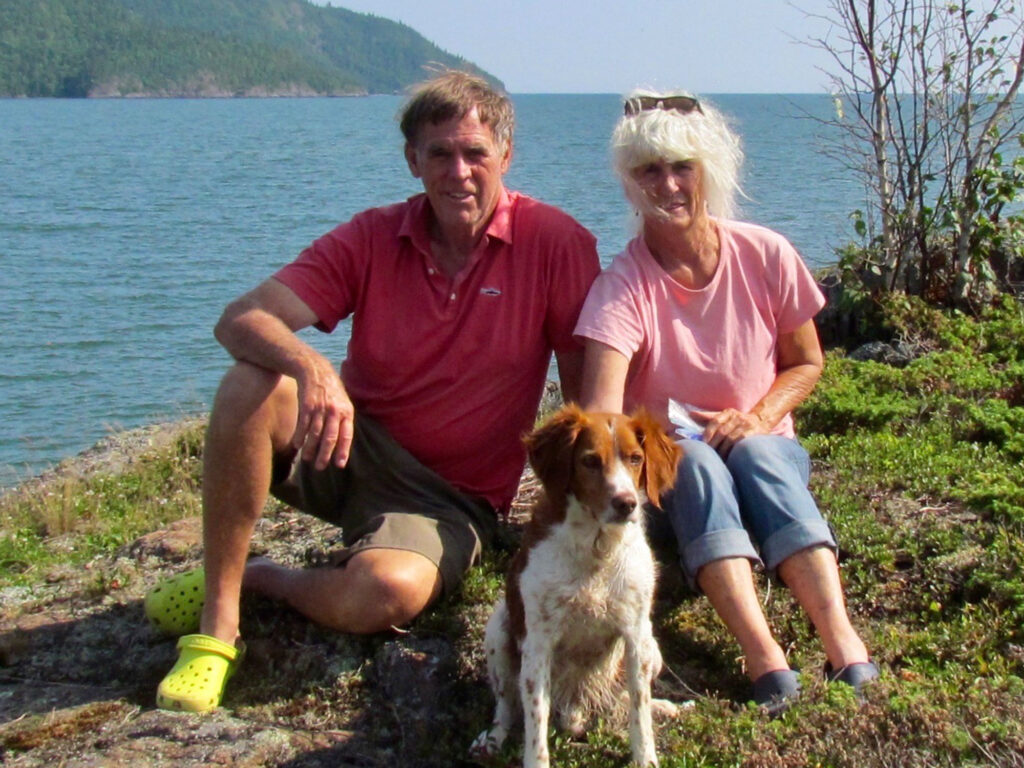
We gazed wistfully over the stern as we left Lake Superior. Left her forever. We had been greeted by loons in Loon Harbour and an eagle at Eagle Harbor. We had walked beaches rarely trod by human feet. We had sat out at night with only our masthead light and the International Space Station on its appointed rounds between us and the Milky Way. We’d had glorious sails past some of the most stunning scenery anywhere on the planet, and we’d only seen two other sailboats in four weeks and 350 miles on Superior’s Canadian shore.
We had heeded Mark Twain’s advice: “Years from now, you will be more disappointed by the things you didn’t do than the things you did do. So throw off the bowlines. Sail away from a safe harbor.” We’re not ready to call the broker quite yet, but we know that should this Lake Superior summer be the last we ever spend on Catamount, it was challenging and rewarding and memorable. We are regretful and grateful, and proud of what we did.
Yes, we broke every one of our own rules at least once, but not the last one: we savored every moment.








